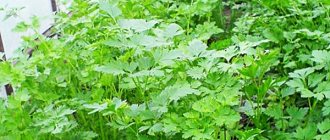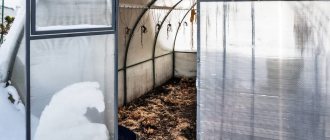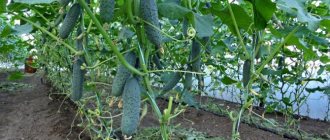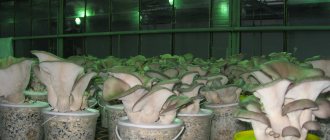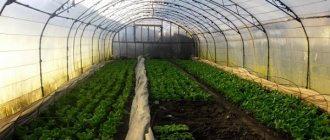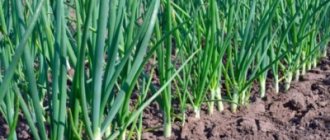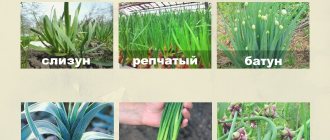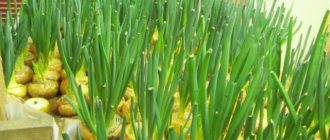A winter greenhouse is great for growing early greens, salads or seedlings. In winter, such a greenhouse has to be heated, which is very expensive if you use electricity. However, there are ways to heat the greenhouse and save on heating costs.
In winter, weather conditions are very harsh to grow fresh herbs or seedlings in the beds. Therefore, many people build a winter greenhouse on the site. It is necessary to create and maintain comfortable conditions for the growth and development of plants - heat, humidity and light. To avoid going broke on heating your winter greenhouse and get an early harvest, follow these simple tips.
Tips for using a cold greenhouse in autumn and winter
With the onset of winter cold
The main season for growing crops is also ending, since winter weather in most parts of the globe is not at all conducive to the growth and development of most plants. However, the use of a greenhouse structure allows you to significantly extend the growing season without fear of temperature and weather conditions.
The greenhouse makes it possible
produce a variety of crops all year round. An important point in “winter” greenhouse growing is the presence or absence of active heating in the greenhouse during the winter period. A heated greenhouse will, logically, be very different in temperature from an unheated one. This will determine not only which crops you can grow most fruitfully, but also how exactly you will need to use the greenhouse structure in cold weather and how to care for it.
Unheated, or, as it is also called, cold greenhouse
- This is a greenhouse room in which no artificial heat sources are used. In winter, in such a greenhouse, a moderate “autumn” temperature is set around 15 degrees Celsius - the temperature level largely depends on the number of sunny days, since the sun will be the only source of heat, and there may not be very many such days in December-January. But due to the fact that the walls of a polycarbonate greenhouse will still retain heat, the microclimate inside the greenhouse will still be warmer than the temperature outside, even at night.
Therefore, the conditions of an unheated winter greenhouse
Not suitable for growing all types of garden crops. Crops grown in cold greenhouses include all winter plants, as well as crops such as cabbage, garlic, radishes, carrots or parsley. That is, despite the cold outside, you have quite a lot of options.
One of the main advantages
Growing in a cold greenhouse means high quality harvest. As you know, growing at low temperatures makes the fruits strong, large, and more palatable. For example, citrus fruits such as lemon or orange are much juicier and healthier when grown at lower temperatures.
Planting a particular crop in winter
, by spring you will have ears that have become stronger from the February cold, which will begin to develop rapidly when the weather warms up - this is another undoubted advantage of “cold” growing.
Finally, purely economic benefit
The advantage of owning a cold greenhouse is that heating is not required for its full functioning. You won’t have to spend money on energy consumption (electricity and heating), which is quite a relevant advantage today. You can even not install any heating systems in the greenhouse at all and still use your greenhouse year-round. In the summer, your greenhouse structure will be used as a “normal” greenhouse, and in the winter it will function as a “cold” greenhouse.
A permanent greenhouse made of polycarbonate allows you to not interrupt the growing process even in the coldest time. You need to choose what can be planted in a greenhouse for the winter based on considerations of economic feasibility, personal preferences and ability to properly care for it. It is important to study the needs of the plants, recommendations for reliable operation and possible difficulties. With the right approach and investment of certain funds, it is not difficult to even organize your own business.
Advantages and disadvantages of winter planting
For the winter, seeds of frost-resistant crops are planted in open ground, capable of withstanding the harsh climate of the cold period without damage. A positive aspect of winter planting is the shift in the beginning of the growing season to an earlier time, which speeds up the possibility of harvesting by two to three weeks.
The seeds undergo stratification at a low temperature and are hardened, the seedlings are disease-resistant and strong, with powerful roots, and are less damaged by pests. The yield of such plants in a greenhouse in winter is usually much higher.
Types of heating systems for non-residential premises
Heating spacious rooms has always been recognized as a non-standard solution.
Unlike residential rooms, the size of public and industrial buildings can reach several thousand square meters.
Vodyanoye
The water heating system is a vicious circle, where the main components are a boiler, radiators and piping. Additionally, circulation pumps, safety monitoring equipment, and drainage devices are connected. There are several types of water heating:
- gravity;
- with forced circulation;
- combined.
In gravity systems, water circulates from the heating boiler through a pipeline to the radiators and back under hydrostatic pressure. It occurs due to the difference in density of the cooled and heated coolant. The heated water becomes less dense and rises through the riser, leading pipes to the radiators. Giving up heat, the coolant acquires greater density and begins to move down the return pipes, returning to the boiler.
Important! A natural circulation solution is suitable for heating a small private house. The principle of operation in heating systems with forced circulation is based on the uninterrupted movement of coolant due to the operation of pumps
They create a pressure difference between the forward and reverse strokes. This option is effective for heating multi-story buildings
The principle of operation in heating systems with forced circulation is based on the uninterrupted movement of coolant due to the operation of pumps. They create a pressure difference between the forward and reverse strokes. This option is effective for heating multi-story buildings.
Among the features it is worth noting the high pressure in the system, the high temperature of the coolant and the use as “standby” heating of buildings.
Pros:
- Energy independence when using solid fuel.
- The ability to regulate the thermal regime in different areas of the building when installing a heated floor system.
- It is permissible to use plastic pipes, which reduces financial costs and installation time.
Minuses:
- The gravity design does not allow you to regulate the heat in different rooms.
- With a gravity system, it is necessary to use large-diameter metal pipes.
Air
This type of heating of buildings, public and non-residential premises gained popularity back in the 70s. last century. The operating principle is based on the use of heat generators, steam or water heaters. The air temperature rises, it flows through the collectors to where a certain climate should be maintained. Air flows are supplied through special louvres or distribution heads. Air heating is organized using different types of boilers.
Reference. The main feature of this system is that air masses are used as a coolant, not liquid.
Uniform heating can be installed both for the entire room and for individual areas.
Photo 1. Air heating system in a non-residential premises. Warm air circulates through special metal blinds.
Pros:
- rapid heating of air masses;
- heating can be combined with ventilation;
- heating the entire room or individual areas.
Minuses:
- To maintain a certain climate, this type of heating must work without stopping.
- The heated masses move upward, causing a warmer zone to form under the ceiling. The difference between the temperature at the top and bottom of the room depends on the height of the ceilings.
Radiant
To heat buildings and non-residential premises, “dark” and “light” devices with infrared radiation are used. The heat source can be liquefied or natural gas.
In rooms where the installation of gas equipment is not allowed, the heat sources are radiant panels that are mounted to the ceiling.
The operating principle of radiant heating varies and depends on the type of infrared heater:
- "Light" devices. The gas is burned using a special burner, on the surface of which the temperature reaches 900 degrees. A hot burner produces the required radiation.
- “Dark” (“pipe”) devices. These are emitters, the radiant energy from which is supplied to reflectors. They direct heat to specific areas. The heating of pipe infrared devices reaches 500 degrees.
- Hanging panels are versatile. They are used in almost all rooms. The system contains an intermediate coolant: water or steam. Heating of water reaches 60-120 degrees, and steam - 100-200 degrees.
Pros:
- High warm-up speed (achieved in 15 minutes).
- The ability to heat only certain areas in unheated buildings.
- Savings due to the absence of energy losses on heating unnecessary areas.
- Does not require maintenance, since the system does not include the installation of filters and pumps.
- Creating a comfortable microclimate (the optimal percentage of humidity is maintained in the air).
- The floor warms up and acts as a secondary heat emitter.
Minuses:
Infrared heaters must not be installed where:
- The ceiling height does not reach 4 meters.
- radiation may affect production processes or product quality;
- fire category A or B has been established.
Tip 5. Maintain the optimal temperature in the greenhouse
Plants grown in a winter greenhouse do not require tropical conditions, so there is no need to waste energy and money maintaining high temperatures. Install a thermometer in the greenhouse and periodically check that the temperature does not fall below the threshold required for normal plant growth. Or you can install a digital thermometer that will transmit readings to your computer monitor. By monitoring the air temperature in your greenhouse, you can use your heater more efficiently.
Landing
Preliminary preparation of the plant is necessary: the shoots of the seedling are shortened to 3-5 buds, cutting off weakened growths, the roots are trimmed and left in water with the addition of a biostimulant (for example, “Zircon”) for 24 hours. The soil at the planting site is prepared in advance by digging it up with humus and the necessary fertilizer complex.
When planting a young crop, ensure its correct location: the root collar is buried 10 cm into the soil. Upon completion of planting, the soil is well compacted, and the tree trunk circle is watered abundantly.
Tip 7: Buy a heated propagator
Instead of heating the entire greenhouse, which is quite expensive, try germinating seeds in a propagator. Invest in a good electric heated mini-greenhouse to germinate your temperature-sensitive seeds. And when the seedlings get stronger, plant them in a greenhouse insulated with bubble wrap, heat them wisely and cover them with geotextiles at night.
If you decide to put a winter greenhouse on your property, do it! And don't worry about heating, because there are ways to do it economically.
And one more important point. During the autumn-winter period, daylight hours are very short. So that your greenhouse crops can develop normally and delight you with a good harvest, take care of lighting in advance.
- Author: Maria Sukhorukikh
Rate this article:
- 5
- 4
- 3
- 2
- 1
(0 votes, average: 0 out of 5)
Share with your friends!
Do-it-yourself heating of a greenhouse in winter
To ensure a stable temperature in the greenhouse, it is best to use several methods of heating it. Cold climatic conditions will not allow heating the greenhouse using the biological heating method. It is necessary to immediately clarify that we are not talking about a film greenhouse, since it is categorically unacceptable for use in winter.
You can heat a greenhouse space with your own hands without having to buy expensive equipment.
The most economical and simple way to heat a greenhouse is to place a pipe. A more expensive solution is to install a gas boiler with a heated floor system. This method will make the greenhouse autonomous.
Heating methods:
- Gas;
- Water;
- Air;
- Pechnoye.
The heating method should be chosen depending on the type of greenhouse. You should also take into account the area of the greenhouse and the crops that will be grown. You can install the equipment yourself after thoroughly familiarizing yourself with the installation technology.
Warming temperature or seed germination
Before starting sowing work, you should prepare the seeds. Their preliminary hardening has a positive effect on productivity. After warming them up, rapid and uniform germination and the appearance of strong, healthy shoots are observed. Warming up protects against bacterial and fungal infections.
Hardening is carried out in several ways:
- Preparation should begin 1.5-2 months before sowing. Place the seeds in a cotton bag and hang them near heating appliances.
- Use a regular table lamp. Place the tomato seeds on a sheet of paper and place them on the lampshade for 3 hours. Cover the top.
- Can be heated in the oven for three hours at a set temperature of 60°C. Disadvantage of this method: regular stirring and constant temperature are required.
- Place tomato grains in a cotton bag and soak for 3 hours in hot water (60°C). Periodically add boiling water so that the temperature does not drop.
- A long-term heating method is used. The temperature is increased gradually: the first two days are kept at +30°C, then three days - +50°C and four days - +70°C. After using this method, plants become resistant to drought.
Hardening is also carried out in another way - by alternating temperatures. It is convenient to use a plastic box or an ordinary saucer. The bottom is covered with a damp cloth or gauze in several layers, grains are laid out, and covered with a damp cloth. Place the box in a warm place (20-25°C). After the seeds hatch, the box is transferred to the refrigerator overnight (+1°-0°C), and taken out for the day and warmed up again. Repeat 5-10 times.
The saucer is covered with a plastic bag. The main thing is that moisture does not evaporate.
It is important to know! If sprouts appear, reduce the time spent in a warm environment by 3-4 hours. The effectiveness of such shock therapy:
The effectiveness of such shock therapy:
- friendly shoots appear;
- helps increase productivity;
- plants are endowed with increased vitality;
- resistant to cold;
- Seedlings can be planted in open ground ahead of schedule.
The method is recommended when planting seedlings in unheated greenhouses.
Problem 2: The soil crumbles like dust.
Let's say you are a conservative to the core and prefer to plant traditional vegetables (like cucumbers, tomatoes, cabbage or zucchini) in the beds, which require a large amount of nutrients. At the same time, you avoid fertilizers, believing that the harvest should be environmentally friendly, and you forget about mulching, because your grandparents didn’t do that. But he’s not averse to digging up the soil properly and pumping up his muscles at the same time. And therefore, it is not surprising that after a few years the once fertile soil in your garden begins to absorb moisture poorly and scatters under gusts of wind.
What to do?
You can, of course, replace the top layer of soil, but this is quite expensive.
Try starting with fertilizers. Add 2-3 buckets of compost per 1 square meter, covering it to a depth of 10 cm. This will make the soil heavier and at the same time make it more nutritious.
Pay attention to the type of soil in your area. After all, some types of soil, for example sandy, dry out quickly, retaining almost no moisture, and therefore require special care
It is not recommended to dig them up more than once a year.
To prevent the soil from becoming dusty, mulch it with available materials, for example, young grass, straw, compost, sawdust, bark, and freshly cut weeds. Mulch will not only protect the soil from further erosion. As it decomposes, it will work as an organic fertilizer, gradually releasing beneficial substances to the crop.
Everything you need to know about mulch, its types and effects. Caution: not all types of mulch are created equal!
Be careful when mulching the soil with fresh organic matter. In large quantities it can destroy your green pets.
Garage water heating scheme and variations
The garage water heating circuit consists of a boiler, metal radiators with a high degree of thermal conductivity and connecting riser pipes (more details: “
Riser heating system - device with examples
Scheme of water heating of a private house - possible types of calculation
«).
The already existing central heating line installed in the house will be the most convenient option for, as already mentioned, a garage adjacent to the main building (read: “
Central heating is both pros and cons
"). Also, this option is suitable for technical premises located near the house, and the distance to the house from them should not exceed 40 meters.
As for an autonomous boiler house, its construction will be economically justified only if the garage building is located at a considerable distance from the central heating main. If the garage is located in a group consisting of several garages, the so-called garage cooperative, then an even better option would be complex equipment of an autonomous heating system for all premises.
Air humidity control
To ensure that the maximum air temperature does not exceed critical values, humidity must be controlled. It’s a good idea to take a few tips into account:
- in winter, supply air to the greenhouse structure heated (positioning the fence away from the plants) and remove it through ventilation to eliminate problems with mold;
- install windows on the sides of the structure every 2 m;
- make them also in the upper part at the ends, ventilate them;
- Install one 200 liter barrel of water on each side of the greenhouse, painted black or at least a dark color. During the daytime, they will accumulate heat and regulate temperature and humidity. At night - share heat with the surrounding space.
The main rule for growing in a greenhouse is to avoid sudden temperature changes during the day or day. They can lead to diseases and death of plants or loss of fruiting.
And another video on the topic:
No matter what kind of greenhouse, this is a very complex system that requires not only the choice of planting material, but also compliance with the criteria of the local climate, which is very important for plant development and abundant fruiting. Nowadays, a variety of methods are used to maintain proper temperature conditions. The temperature in the greenhouse can be raised or lowered using common but very effective measures. It is not at all necessary to purchase expensive equipment for heating or ventilation, just mulching, creating special shelters from film or mini-greenhouses that are installed above the beds. In some cases, it is enough to paint the outer surface of the walls with ordinary chalk.
The influence of different temperatures on seedlings
At high temperatures, tomatoes quickly begin to bloom and bear fruit, but because of this, the number of fruits in the future will be much smaller. When the seedlings are placed in a place where the temperature is lower than optimal, the growth of the plant is significantly slowed down, but the result is a very good harvest.
If it differs greatly from the required parameters, the tomato bears fruit much later and rather poorly. These tomatoes have a significantly lower level of sugar and fruit acids.
Sudden temperature changes can negatively affect crop growth. When the thermometer drops to +5 °C, the plant stops developing.
Minimum
It is important to ensure that the place where the seedlings are located has an optimal thermal regime. The mark on the thermometer should not reach +10 °C, otherwise the growth of the plant will stop
Tomatoes love heat very much, so it is recommended that the minimum value be +12 °C at night and +23 °C during the day.
Maximum
The temperature at which seedling growth stops is above 28 °C and below 13 °C. In this case, the plant's pollen is sterilized.
One of many factors
Temperature, although the leading one, is far from the only factor that contributes to filling our country baskets with various gifts of nature. If you list these factors, you get a rather large list: sunlight, soil moisture and fertility, planting density... ...and that's not all. Plants, like any living organism, exist only under a favorable combination of many different conditions.
But, since we are creating a greenhouse with the goal of primarily managing the heat inside them, we will devote this article to temperature.
Ventilation
